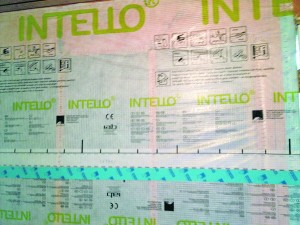
Exterior vapor open membrane with vertical strapping to create a rain screen.
By Michael Goetinck
About 20 years ago, an old time Yankee master carpenter told me, “Michael, it doesn’t matter if water gets in as long as it can get out.” In one sense he was right, but his experience was largely in buildings with high drying potential (i.e., no insulation, roof and siding intact, high air infiltration and exfiltration, lumber from old growth trees) as opposed to the homes that many of us want to create or retro-fit for high performance with currently available materials. I’ll update his statement by saying that a building’s ability to dry out needs to be greater than, or at least equal to, its potential for getting wet.

Interior smart vapor retarding membrane. Photos by Michael Goetinck.
Bulk water has to be managed at the source because if it isn’t, you won’t have a high performance building. The other type of moisture that people and building codes spend a great deal of time addressing is vapor. Moisture in vapor form should also be managed at the source through the use of vapor retarding membranes and mechanical ventilation. The closed-cavity building assemblies should be constructed in such a way that if diffusional moisture gets into them they have the ability to dry before damage occurs. This approach ensures the health and safety of the building and its occupants. Below, I’ve outlined an approach that I’ve found to be successful.
Bulk water: all of the grade, foundation, roof, and wall details have to be done in such a way that bulk water does not enter the building. If there is no way to prevent it from coming into the basement ( rubble-stone foundations, springs running through the basement, etc.) then it can be managed by installing a drainage system in the basement that allows a way for water to leave the building without it affecting the building’s assemblies.
Vapor. This can come from a number of sources, including cooking, bathing, house plants, pets, and people. It can also come from basements and crawlspaces. Mechanical ventilation; whether it’s at the source (bath and kitchen fans), whole-building (heat recovery ventilation), or a combination of the two is important to install. These systems can be sized for the anticipated loads. Barriers below grade to cover dirt or concrete floors and foundations will prevent vapor from getting into the basement or crawlspace. All of these methods will work to keep interior relative humidity low enough (certainly below 50%; preferably closer to the 20-30% range) that diffusional moisture becomes more easily managed.
Diffusional moisture. A closed-cavity assembly that is vapor-open on at least one side and filled with hygroscopic insulation will give the best results. Assemblies designed to dry to the interior need to be constructed using a membrane with high diffusional tightness during the heating season and high diffusional openness during the rest of the year. The best hygroscopic insulation material is 100% borate- treated cellulose. By using these materials in concert, any moisture that gets into the assembly will spread throughout the insulation without harming it or significantly reducing its ability to insulate and dry out before the durability of the building is compromised.
Michael Goetinck is the owner of Snowdog Construction, Ltd, in Norwich, VT. This series will continue in Green Energy Times, where the author will cover other topics that can help achieve the deep energy measures which help buildings’ energy performance, and so can benefit us all.








Leave a Reply